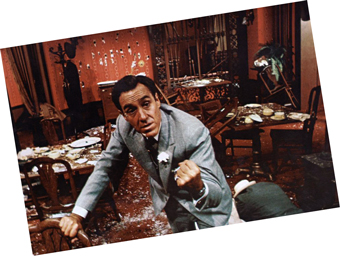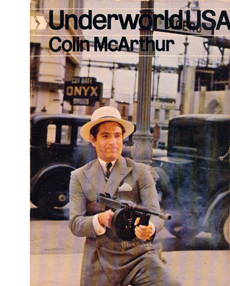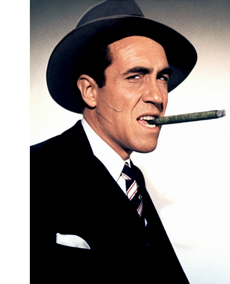
 |
|
|
|
Roger Ebert's 1967 review of The St. Valentine's Day Massacre hadn't much use for director Roger Corman's semi-documentary style. The critic would have preferred a simplified, fake vision of gangland's most famous historical event. But director Roger Corman uses his newfound 20th-Fox studio resources to make the show an unbroken series of tense confrontations and (for 1967) wildly violent gangland rub-outs. The movie has become a genre favorite, and its authenticated account encouraged fans to look more deeply into the true-life stories behind their favorite gangster bad guys. Corman even gets in a cynical/subversive jab, comparing the tactics of bootlegging hoodlums to those of modern corporations, and nations. 
The success of Corman's American-International Vincent Price movies gave him the opportunity to pursue a career as an A-List directing talent. Corman soon found that he wanted no part of the chaos of studio filmmaking -- the overhead, the loss of control -- and retreated to the independent world that he knew so well. When A.I.P. began to second-guess him the same way, Corman took the next logical step and formed his own distribution company. Fresh from his smash hit The Wild Angels, Corman fixated on a violent subject in a year of particularly violent movies: Bonnie & Clyde, Point Blank. Before the breakout of Sam Peckinpah and ubiquitous violence, the machine-gunnings and rub-outs in The St. Valentine's Day Massacre were considered pretty extreme for screen bloodletting. Film historians also consider Corman's thriller a major step in the development of the gangster genre. Chicago, 1929. Al Capone and Bugs Moran (Jason Robards and Ralph Meeker) compete for "market space" in the booze and vice rackets on the North Side. Both camps formulate elaborate scenarios to eliminate their competition. Moran hopes to weaken Capone by replacing the Mafia chieftain with a ringer of his own, Aiello (Alex D'Arcy). Moran's sluggers Peter and Frank Gusenberg (George Segal and David Canary) go forward with this plan, not realizing that Capone's lieutenant "Machine Gun" Jack McGurn (Clint Ritchie) is setting Moran up for a major hit. Capone doesn't care who else gets killed as long as Bugs goes down for the count. The St. Valentine's Day Massacre starts with both a "this is true" title card and a hectoring narration courtesy of the ubiquitous Paul Frees. Passersby react to the ferocious sound of the slaughter on February 14. The chief witness is actress Barboura Morris, who had just served a similar story-opening function for Corman, cringing at the sight of Peter Fonda in The Wild Angels. 
Scriptwriter Howard Browne had mostly worked in television but was also responsible for one of the better late-1950s gangland films, Portrait of a Mobster starring Vic Morrow as Dutch Schultz. The gangster fare that followed TV's popular The Untouchables was able to name names and recount actual mob history, but still shied away from telling the whole truth. Pictures like Murder, Inc. pointedly avoided admitting the role of corrupt police departments, judges and other public officials in the scandals of organized crime. How else could Moran's hoodlums fire machine guns on city streets with impunity? In The St. Valentine's Day Massacre Capone's executives discuss the inconvenience of buying policemen and suborning judges. His board meeting is not that much different than any business gathering. Ambitious underlings vie for Capone's approval while the established participants steer the boss's attention away from their failures and toward their successes. Paul Frees' stentorian voiceover implies that all business and political organizations are essentially 'gangs' at war with competitors. It's Dog Eat Dog out there. The nationalities of Corman's gangsters are undisguised, and real ethnic slurs are used, even some that have fallen out of usage. Italians are called wops and spaghetti-snappers. Jack McGurn is shown eating pasta, apparently trying to 'be more Italian' for his boss Al Capone. The Moran mob gives a hard time to broken-down trucker Sorello (Frank Silvera) for having a Sicilian accent. The script contains an interesting revelation: because Al Capone is merely Italian and not Sicilian, he cannot rise higher in the New York-operated Mafia. 
Chicago speakeasies operate practically in the open, while the newspapers indulge Moran and Capone's outrageous claims that they are ordinary citizens and businessmen. Browne's script also equates the 'anything goes' violence in Chicago to the unrestrained over-speculation in the stock market, which in less than six months would collapse and plunge the nation into a Depression. Capone's Chicago isn't some crazy aberration in the American fabric -- it is America. Corman breaks up his narrative with frequent flashbacks, restaging earlier violent episodes in flashback form. Hymie Weiss and Dion O'Bannion (John Agar) are shot down in broad daylight. Trying to take a lunch break, Al Capone is besieged by a drive-by parade of cars blasting an entire restaurant with machine guns. Anybody can murder anybody. The Chicago solution to a business impasse is essentially the same one employed in 1930s Japan: government by assassination. Additional voiceovers bind together a fractured narrative. We observe the crooks in action while the narrator feeds us their sordid backgrounds. Charles "Bugs" Moran was at one time a horse thief. Peter Gusenberg stole his dead mother's wedding ring. 1 Corman riffs on famous gangster lore, borrowing entire scenes from The Public Enemy. Peter Gusenberg harasses a speak owner, while John Scalise (Richard Bakalyan) and his partner stake out a machine-gun emplacement in a boarding room opposite the Clark Street garage. Corman sacrifices dramatic depth to the needs of docu realism. Only a couple of scenes do not directly serve the story. To generate some sex appeal, George Segal roughs up his moll Myrtle (Jean Hale of In Like Flint) over a fur coat. Corman shoots the action with a hand-held camera but it doesn't come off well, as if George Segal and Jean Hale were reacting to what they probably felt was rushed direction. In another scene David Canary is robbed by his woman for the night, Joan Shawlee (The Apartment). 
The film was severely criticized for the miscasting of Jason Robards, who looks nothing like Al Capone. Corman had originally envisioned Orson Welles as Capone and Robards as Moran, but Fox vetoed Welles as 'undirectable'. Robards' dramatic excesses aren't wrong for the character but he lacks an essential physical intimidation factor. It's still an "A" acting job. George Segal throws away the role but has fun adding a cocky gunsel to his acting scrapbook. Ralph Meeker's Bugs Moran stays away from the violent action. The great actor has barely a scene or two to show his stuff, which is a big mistake -- the movie needs a stronger grudge between Moran and Capone. Yet when Meeker furrows his brow he looks twice as murderous than either of his co-stars. The gangsters and their hangers-on are played by actors as diverse as Harld J. Stone, Joseph Campanella, Bruce Dern, Kurt Krueger, Joe Turkel, Tom Reese, Gus Trikonis, Alex Rocco and Reed Hadley. The big cast allowed Corman to reward some of his loyal acting associates with honest-to-goodness Guild jobs. In substantial roles or solid bits are Bruce Dern (The Trip), Leo Gordon (The Intruder), Jonathan Haze (Little Shop of Horrors), Betsy Jones-Moreland (Last Woman on Earth), Dick Miller (Not of this Earth), Barboura Morris (Teenage Doll, A Bucket of Blood), Leo Gordon (The Haunted Palace) and Jack Nicholson (The Little Shop of Horrors, The Raven). According to his autobiography, Corman couldn't offer the unemployed Jack Nicholson a big role because Fox insisted on a contract player. Jack was so broke and down on his acting prospects that he chose his bit part on the basis of how much work was involved. His hood character was carried for most of the 35-day shoot. Nicholson is seen only in about a dozen shots and has only one wheezed line about covering bullets with garlic. Corman's perennial replacement-pitcher director Monte Hellman served as a dialogue coach. We can imagine he and Jack going over that one line 500 times, lamenting Nicholson's doubtful future as a Hollywood actor. 
While waiting to see how events converge on the infamous massacre, we're given a couple more violent murders to savor. Although the gore is off-camera, Corman's stagings are confrontationally disturbing. George Segal shoots Patsy Lalordo without emotion, while Jason Robards becomes a Sweeney Todd-like maniac with a straight razor. To make the actual massacre top what's come before, Corman uses jarring cutting to bolster the pitiless slaughter of what we know to be mostly unfortunate bystanders. True to the chaotic history of early gangland, the whole bloody mess is a complete mistake -- the killers have misidentified their key target. Corman emphasizes the brutality by lingering on a strong image. After Dick Miller and another thug administer a coup de grace, we pause to watch creepy puffs of smoke curl from the barrels of their shotguns. Corman rushes the finish, a quick wrap-up of the fates of the participants in the massacre. Several thugs just turn up dead, without a clear explanation. Years later in Goodfellas, Martin Scorsese would illustrate how natural it is for a gang to wipe out its own just for insurance, to eliminate potential witnesses. Corman uses his higher budget to move his camera more than usual, yet his show lacks an overall style. The lighting is flat and some of the costumes and settings are on the tacky side. Corman doesn't worry about things like anachronistic hairstyles. The street sets on the Fox lot are underdressed and under-populated, and look phony even after the addition of a few high-angle matte paintings. During the restaurant shooting we can see off the set onto the tall trees on the Pico Blvd. side of the studio. Corman's picture captures the ferocity of his setting, but we'd have to wait for the Godfather movies to see a gangster vision that would fully capture the American imagination. The St. Valentine's Day Massacre is really about a naïve America that bought into the myth that organized crime is essentially harmless, and that the stock market bubble could go on forever. Corman never stressed the intellectual content of his films but even his early efforts tend to have a strong message or two. When his narrator compares gangland Chicago to the policies of nations and corporations, it's no empty statement. |
|||||||||||||||||||
Review Staff | About DVD Talk | Newsletter Subscribe | Join DVD Talk Forum
Copyright © MH Sub I, LLC dba Internet Brands. | Privacy Policy
Subscribe to DVDTalk's Newsletters
|